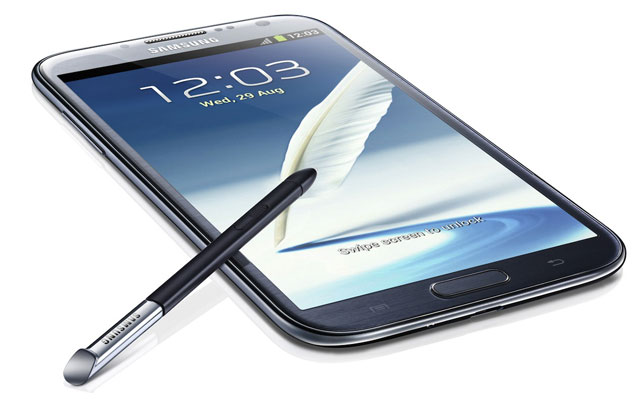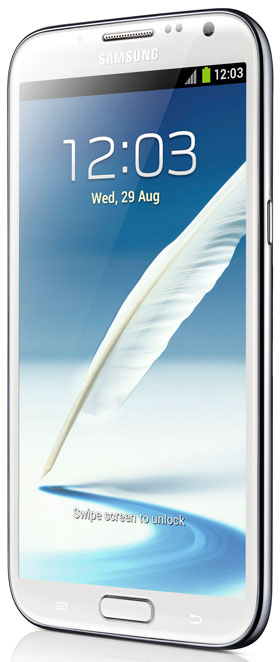
When we reviewed Samsung’s first Galaxy Note a year ago, we wondered whether it was the best phone ever made or whether the Korean electronics giant was playing some sort of elaborate practical joke on its customers. The thing was just so big!
Yet, a year later, and the Note’s successor, the Note 2, doesn’t feel nearly as large — despite the fact that its screen has grown from 5,3 inches to 5,5 inches. The reason it’s become more acceptable is the growing size of smartphone screens across the board. Samsung’s own Galaxy S3, with its 4,8-inch display, and HTC’s One X, with a 4,7-inch screen, no longer seem, to us anyway, to be too big.
Still, stepping up from the S3’s 4,8 inches to 5,5 inches does make the Note 2 feel like a borderline tablet. The original Note, in fact, created a new category of device, “phablets” — a cross between tablets and smartphones. The Note 2 and its predecessor are just big enough to elicit curious stares from passers-by when you press one of them up against the side of your head to make or receive a phone call. But let’s be honest, you won’t be buying the new Note for its call-making functionality. This is a device for reading, surfing the Web and taking handwritten notes.
In essence, the Note 2 is the Galaxy S3’s big brother. The two phones look almost identical, with the same rounded corners (wait, didn’t Apple patent those?), front-facing home button and camera placement. They even both have cheap plastic back covers. The only real differences are the screen size and the fact that the Note 2 comes with an “S Pen” stylus.
Let’s begin with that huge screen. Boasting a resolution of 1 280×720 pixels for a pixel density of 267 pixels per inch, the display is vivid and super bright, and reading the full versions of websites — as opposed to those formatted for phones — is a pleasure. So is reading magazines in Zinio and watching 720p high-definition movies.
 Despite its enormous screen, the phone still fitted comfortably in your reviewer’s hand. Of course, reaching across the entire screen with a thumb is virtually impossible without dropping the phone, so expect to use this device with two hands most of the time. In fact, if you’re unsure of the size, make sure you play with it in-store before making a final purchasing decision. But also know that the large screen size is a grower. The S3 feels a little dinky after using the Note 2.
Despite its enormous screen, the phone still fitted comfortably in your reviewer’s hand. Of course, reaching across the entire screen with a thumb is virtually impossible without dropping the phone, so expect to use this device with two hands most of the time. In fact, if you’re unsure of the size, make sure you play with it in-store before making a final purchasing decision. But also know that the large screen size is a grower. The S3 feels a little dinky after using the Note 2.
Other than size, the other notable difference between the Note 2 and the S3 is the former’s use of an S Pen stylus, which is tucked away neatly into the bottom of the device. We doubt we’d use the stylus much — it’s not essential to the phone’s functioning — but those who have an artistic flair or those who like to scribble out notes rather than using a touchscreen keyboard will find it useful.
Pulling the stylus out of the phone brings up Samsung apps specifically optimised for S Pen, including ones for drawing and note taking. It’s highly sensitive, with different pressure options, with Samsung licensing technology from pen-display and stylus specialist Wacom. It does its job well, with plenty of gestures available, and is sturdier than the pen included with the original Note. Handwriting recognition is pretty good, too, though you’ll have to concentrate on writing neatly. Doctors need not apply.
We have no doubt there’s a market for stylus-driven smartphones, but the S Pen, even with its dock, is also obviously a lot easier to misplace than an index finger. So, it’s a good thing it’s not integral to the operation of the phone.
The Note 2 runs Jelly Bean — officially Android 4.1 — and, as with other Galaxy devices, comes with Samsung’s TouchWiz overlay. We don’t dislike TouchWiz, although we don’t particularly like it either. It’s certainly not as good looking, in our view, as HTC’s Sense. We really wish Samsung — and its rivals — would give users the option of running vanilla Android at first boot after purchase.
Samsung has a few other nifty tricks up its sleeve with the Note 2, including split-screen mode, which allows you to run two apps side by side. Not all apps are supported, but an impressive array will do it.
For a phone of its size, the Note 2 is remarkably light, weighing in at just 180g — that’s just 40g more than the much smaller iPhone 4S.
All the latest wireless communications hardware is packed in, too, as you’d expect from a high-end smartphone: quad-band aerial, 21Mbit/s 3G, dual-band Wi-Fi, Bluetooth 4.0, DLNA and NFC. The huge 3 100mAh battery will also easily get you through a day of moderately heavy use — impressive given the screen real estate it has to power.
The phone packs in a powerful Exynos 4412 1,6GHz quad-core processor and the RAM has doubled to 2GB over the first-generation Note.
All in all, the Note 2 is a great device and a solid improvement over the first one. And, as phones get bigger, it no longer looks as out of place as it might once have. Heck, maybe Samsung needs to think about pushing the 6-inch boundary when it releases the Note 3 in late 2013. By then, 5,5 inches may be looking a little small. — (c) 2012 NewsCentral Media
- The Samsung Galaxy Note 2 costs R7 400 without a contract




